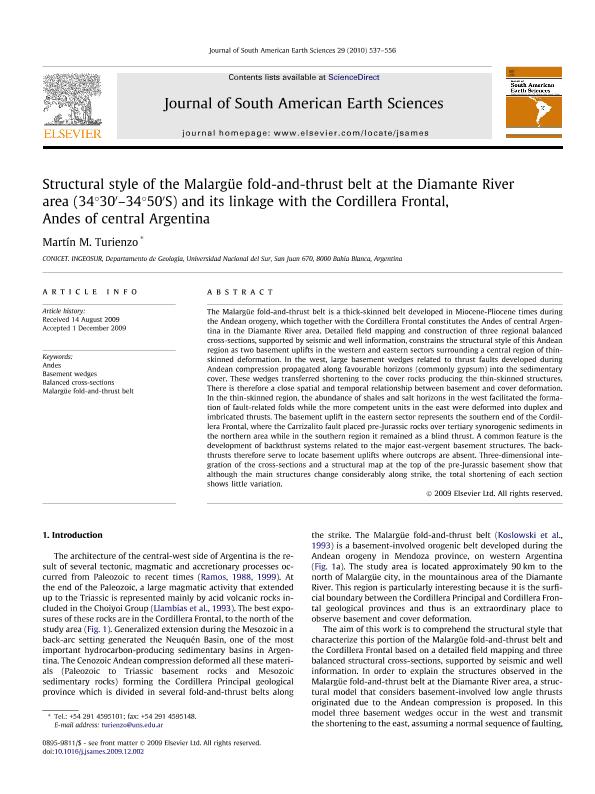Mostrar el registro sencillo del ítem
dc.contributor.author
Turienzo, Martin Miguel

dc.date.available
2019-03-19T20:08:41Z
dc.date.issued
2010-04
dc.identifier.citation
Turienzo, Martin Miguel; Structural style of the Malargüe fold-and-thrust belt at the Diamante River area (34°30'-34°50'S) and its linkage with the Cordillera Frontal, Andes of central Argentina; Pergamon-Elsevier Science Ltd; Journal of South American Earth Sciences; 29; 3; 4-2010; 537-556
dc.identifier.issn
0895-9811
dc.identifier.uri
http://hdl.handle.net/11336/72046
dc.description.abstract
The Malargüe fold-and-thrust belt is a thick-skinned belt developed in Miocene-Pliocene times during the Andean orogeny, which together with the Cordillera Frontal constitutes the Andes of central Argentina in the Diamante River area. Detailed field mapping and construction of three regional balanced cross-sections, supported by seismic and well information, constrains the structural style of this Andean region as two basement uplifts in the western and eastern sectors surrounding a central region of thin-skinned deformation. In the west, large basement wedges related to thrust faults developed during Andean compression propagated along favourable horizons (commonly gypsum) into the sedimentary cover. These wedges transferred shortening to the cover rocks producing the thin-skinned structures. There is therefore a close spatial and temporal relationship between basement and cover deformation. In the thin-skinned region, the abundance of shales and salt horizons in the west facilitated the formation of fault-related folds while the more competent units in the east were deformed into duplex and imbricated thrusts. The basement uplift in the eastern sector represents the southern end of the Cordillera Frontal, where the Carrizalito fault placed pre-Jurassic rocks over tertiary synorogenic sediments in the northern area while in the southern region it remained as a blind thrust. A common feature is the development of backthrust systems related to the major east-vergent basement structures. The backthrusts therefore serve to locate basement uplifts where outcrops are absent. Three-dimensional integration of the cross-sections and a structural map at the top of the pre-Jurassic basement show that although the main structures change considerably along strike, the total shortening of each section shows little variation. © 2009 Elsevier Ltd.
dc.format
application/pdf
dc.language.iso
eng
dc.publisher
Pergamon-Elsevier Science Ltd

dc.rights
info:eu-repo/semantics/openAccess
dc.rights.uri
https://creativecommons.org/licenses/by-nc-sa/2.5/ar/
dc.subject
Andes
dc.subject
Balanced Cross-Sections
dc.subject
Basement Wedges
dc.subject
Malargue Fold-And-Thrust Belt
dc.subject.classification
Geología

dc.subject.classification
Ciencias de la Tierra y relacionadas con el Medio Ambiente

dc.subject.classification
CIENCIAS NATURALES Y EXACTAS

dc.title
Structural style of the Malargüe fold-and-thrust belt at the Diamante River area (34°30'-34°50'S) and its linkage with the Cordillera Frontal, Andes of central Argentina
dc.type
info:eu-repo/semantics/article
dc.type
info:ar-repo/semantics/artículo
dc.type
info:eu-repo/semantics/publishedVersion
dc.date.updated
2019-03-08T20:20:13Z
dc.journal.volume
29
dc.journal.number
3
dc.journal.pagination
537-556
dc.journal.pais
Estados Unidos

dc.journal.ciudad
Amsterdam
dc.description.fil
Fil: Turienzo, Martin Miguel. Consejo Nacional de Investigaciones Científicas y Técnicas. Centro Científico Tecnológico Conicet - Bahía Blanca. Instituto Geológico del Sur. Universidad Nacional del Sur. Departamento de Geología. Instituto Geológico del Sur; Argentina
dc.journal.title
Journal of South American Earth Sciences

dc.relation.alternativeid
info:eu-repo/semantics/altIdentifier/doi/http://dx.doi.org/10.1016/j.jsames.2009.12.002
dc.relation.alternativeid
info:eu-repo/semantics/altIdentifier/url/https://www.sciencedirect.com/science/article/pii/S0895981109001783?via%3Dihub
Archivos asociados
